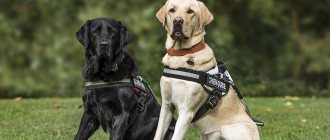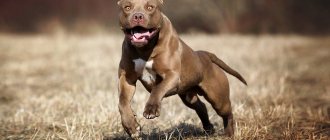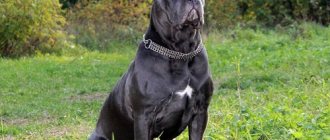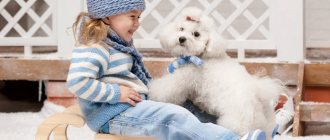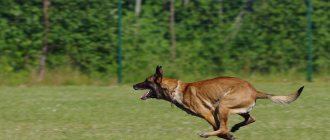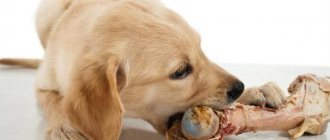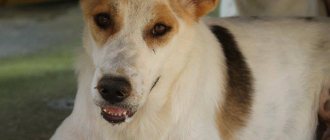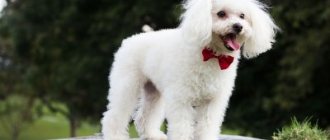Four-legged pets have lived side by side with humans for more than 20 thousand years. First of all, dog lovers value their loyal character and high intelligence. Despite this, the main goal of domesticating wild wolves was the ability to help in various areas of life.
With appropriate training, many pets become suitable for work in a wide variety of fields, including customs service and law enforcement. Below you can find out which dogs are service breeds - and whether it is worth getting them as a regular companion.
Alabai
The second name of the breed is Central Asian Shepherd. This is one of the oldest and very large dogs, reaching 65-70 cm at the withers.
If anyone thinks that the Alabai was bred as a fighting dog, then he is completely wrong. This is a guard and herding dog, with a fairly calm disposition and independent character.
Its dimensions allow the Alabai to be a fearless dog, but it is not inclined to rush at anyone first. He will simply warn, and if this does not have an effect, measures will be taken.
All the legendary aggression of the breed is the fault of careless owners who place the priority not on the dog’s performance qualities, but on its capabilities. Also, the dog is very touchy and even vindictive, so punishing him is the same as cutting off the branch on which you are sitting.
Training must be approached wisely, since the Alabai will not follow orders like a robot: he needs to convey the need for certain actions. Therefore, training should begin almost from the very birth of the puppy. And if you cannot provide your dog with a decent upbringing, it is better to entrust it to a professional, since “three classes of parish” is not for such a serious breed.
Video: alabai
Selected groups by nature of service
Based on the nature of their service, all types of service dogs can be divided into several groups. They have the following names:
- search, guard and customs dogs called upon to search for dangerous substances, weapons and criminals, as well as patrol state borders and other important objects;
- search and rescue, used to save people in extreme situations;
- shepherds, divided into those who help with grazing and those who protect livestock;
- bodyguards who provide protection to individuals and facilities;
- sappers trained to search for explosives and mine clearance;
- rehabilitation, involved in canistherapy;
- guide dogs and other assistance dogs that help the blind, visually impaired and other people with disabilities;
- sleds used to transport goods and people in the Far North;
- hunting, helping to track, drive, catch and bring prey;
- sentries protecting territory or individual objects.
Four-legged pets are actively used by employees of the Ministry of Emergency Situations and the Federal Penitentiary Service, border guards, military, police and rehabilitation centers. To enter the service, they are required to undergo training courses: OKD and ZKS.
Alaskan Malamute
It is also a very ancient breed and is regularly confused with the Husky. But the Malamute has a completely different build and color. This is a very hardy sled dog, whose place is in the Far North. Height at the withers is 63-58 cm.
Up to three years old, Malamutes are little devils with horns. Their restless nature cannot calm down even after a very long walk with loads. and they, like huskies, selflessly dig holes. Therefore, the owner needs to constantly deal with it. And only after three years the dog becomes calmer.
Malamute is very sociable and good-natured. But at the same time, he is very independent, and sometimes decides for himself what to do. Such a dominant needs strict training. If a Malamute becomes swollen from boredom, it begins to destroy everything around it, so you need to give it a good physical load.
The breed gets along well with other domestic animals, but outside the home their hunting instinct awakens, and other animals often become the dog’s prey.
Malamutes also have an excellent memory. This is worth considering, especially if the pet has done something wrong and you want to punish it. The dog will definitely remember the insult, and if necessary, may even take revenge.
Video: Alaskan Malamute
Labrador Retriever
Labradors have a reputation as a loving family dog, ideal for active people, especially teenage children. These are balanced, calm, intelligent and gifted dogs. They are affectionate and obedient, insightful and faithful.
In official work, the keen sense of smell of the Labrador Retriever is considered ideal for search work, especially for detecting explosives and narcotic substances. The retriever has a wide and slightly elongated muzzle, which makes it possible to take in a lot of air through the nose and make it easier to detect the desired smell.
To teach a dog a special job, it takes at least two years of hard work by a specialist dog handler.
The Labrador Retriever is muscular and proportionally built. The coat is short and thick, the undercoat is waterproof.
Life expectancy is 12-13 years. The height of a male is on average 56-57, and that of a female is 54-56 centimeters, weight, respectively, is 27-40 and 27-35 kilograms.
The Labrador Retriever has long been a city dog; it is not suitable for being kept on the street. Walking on a leash is not enough for the animal; it is necessary to provide physical activity, jogging in the park or in places designated for walking dogs.
Recommended for active families with teenage children. You can take your dog on trips. Labradors love to swim.
American Staffordshire Terrier
The fame of this dog runs ahead of her. And all because Amstaffs can be both complacent, good-natured people and excellent companions, and warriors without fear or reproach.
The breed was bred to be a protector for the family , but its intelligence and physical characteristics were rated a little in the wrong direction. Therefore, Staffordshire is a frequent participant in dog fights. The staff rushes at the enemy instantly, practically without barking or growling, and few will be able to stop him.
By the way, staff is great for keeping in an apartment. Medium size and short hair usually do not cause owners much trouble. Well, except that his mobility can sometimes be confusing: how can you move so quickly with such a physique?
Amstaff training is not for amateurs. And although there are cases when a dog understands its owner without words, training such a serious dog requires a special approach. He should not be treated roughly and anger should not be cultivated in his character. At the same time, it is quite difficult to piss off a Staffordshire, but if this happens, it will not seem like much.
The American Staffordshire Terrier will gladly take part in all games; it gets along well with children, but it is still not worth leaving it with a very small child.
Video: American Staffordshire Terrier
Briefly about the main thing
- Each breed has its own characteristics that must be known and understood.
- Any owner can learn the “language” of a pet: barking, habits, mood.
- Attention, praise for commands, perseverance and love are integral attributes of a dog breeder’s life.
- With the help of faithful dogs, thanks to successful selection and proper training, many tasks are performed that a person is sometimes unable to cope with on his own.
- Dogs serving in the police, the Ministry of Emergency Situations, and medicine are raised in special nurseries. Subject to further education at home, socialization, walking on the dog park, and training are necessary.
- Each breed has its own appeal. When choosing a puppy or a grown-up pet, you need to know what awaits the owner, count on your strength and resources for prevention, treatment, nutrition and education.
English Mastiff
A real giant in its class. The height of dogs starts from 70-75 cm at the withers, but the breed is endowed with a very good-natured disposition; it is quite difficult to anger them. And this in no way fits with their glorious military past - mastiffs are not fools to lie on the sofa, and if they are together with their owner, it’s generally wonderful. Real imposingness of English aristocrats!
The most interesting thing is that mastiffs really love to be close to their owner. It can be a powerful Herculean hug, and sometimes the dog imagines itself as a kitten and tries to climb onto your lap. Need I say that the worst punishment for this dog is loneliness?
Strange, right? It seems to be a service dog, and not some kind of sissy. But in the good heart of a mastiff there is also room for mistrust of strangers. The dog is unlikely to be the first to attack, but driving the enemy into a corner is always welcome.
The mastiff exhibits such qualities when properly raised. If the owners instill kindness and affection in the dog, then that’s how it will be. But if you touch on your combat past, you will have a fearless legionnaire at your disposal. Are you the only one who needs a dog like this?
Despite the fact that the mastiff is an avid homebody, he still needs walks. He won’t rush around like crazy after a stick, but a leisurely, sedate step is just his gait.
But training will bring many surprises. Mastiffs are solid “C” students, but not because they lack intelligence. This is a large, self-sufficient and stubborn dog and with all its appearance: “Why do I need training, I’d rather lie on the sofa.” Therefore, you need to be persistent here.
You should not get a mastiff if the owners are away from home for a long time. And if there is a very small child in the family, it is better to think about a different breed, since the impressive carcass of a mastiff can become a source of injury.
Video: English Mastiff
Conventions of division and specialization
There is some discrepancy in terminology and the meaning put into the definition of service dogs. In Western countries, without taking into account the specific breed, dog handlers divide everyone into two groups:
- working animals that can perform specific tasks for human needs;
- pets kept primarily for the pleasure of their owners.
Animals live in families in different conditions and with different views on education. In order not to lose the inherent beneficial qualities, while maintaining the requirements of appearance, various exhibitions and tests are carried out among dogs. At these events, experienced judges evaluate participants for standards and inherited abilities.
In Russia, after the revolution during the formation of a young state, a slightly different division arose. All dogs were conditionally divided into three groups:
- official;
- hunting;
- decorative.
The first ones fell under the control of law enforcement agencies - the army and the police. And these were the main areas of application of canine capabilities. Security, protection, search for criminals, suppression of illegal actions. Accordingly, breeds were selected that were capable of performing the assigned tasks as efficiently as possible. Large, strong, angry, with a developed sense of smell, hearing and an innate distrust of strangers.
Gradually, the list of jobs in the national economy that dogs could do well increased. The requirements for the animals themselves also changed. Size and aggressiveness became a hindrance in many cases. And the main selection criterion
Could perform:
- mobility;
- endurance;
- controllability;
- goodwill;
- intelligence.
The definition of missals expanded. It included breeds from other groups, and new ones were developed that met specific requirements. Today, many hunters and some ornamental species can be counted among them. After all, regardless of the size, color and length of the coat or the shape of the body, some of the abilities of dogs are tens of times greater than those of humans. By and large, indoor breeds, or as they are often called, companion dogs, have their own special tasks. Being a person’s friend is also, to a certain extent, a job and a calling. And all our attempts to divide and classify are only an expression of a subjective view. And it does not always correspond to the actual state of affairs.
For example, the well-known Poodle. A kind of cheerful, fluffy and funny-haired “toy”. But few people realize that under the pretty face hides a superbly developed dental system that is in no way inferior to the German Shepherd. And for some time, poodles were used as a service dog to guard the state border of France.
There are different specialties of dogs. Each business requires special skills and abilities. And some breeds always cope with the task better than others - they have the best initial data for this. Their first tasks were to help with hunting and guard their homes. Accordingly, preference was given to individuals with sufficient strength and agility to fight large animals and resist predators. When herds of domesticated herbivores appeared, they also needed to be protected. Subsequently, guard qualities alone turned out to be insufficient. People wanted to put four-legged assistants and management processes on their shoulders - this is how shepherd dogs appeared. In the conditions of the north and long winters, specialization of riding animals arose and selection went in the direction of selecting the animals most suitable for this.
Wars, gladiator fights, hunting waterfowl, fast-running or burrowing animals. Fighting rats and helping fishermen in their difficult and dangerous fishery - the best canine representatives were selected for each job, and strict further selection for working qualities led to the formation of a separate breed with stably inherited traits.
As can be seen from the above, all representatives of the dog family, to one degree or another, serve people, performing the tasks assigned to them. But still, for many readers, the term Service Dogs implies animals trained to forcefully confront humans. These are special breeds that require competent treatment and education. Otherwise, from a friend and helper, they turn into a mortal danger to others, and sometimes to the owner. Now we will look at several of the most striking and famous breeds from this worthy category.
Belgian Shepherd
This is a beautiful and active service dog, whose height ranges from 55-60 cm. There are 4 subspecies of Belgians, and they all differ from each other, although in general one cannot help but notice the general similarity.
Tervuren
characterized by impulsiveness.
His lively character requires constant communication with one owner of his choice. Whatever idea you propose to the dog, the idea will be picked up with all readiness. Tervuren
Laekenois
quite polar. Either they are cheerful and playful, or they can turn away with an absent look and lie down to rest. But if necessary, the dog shows excellent guard qualities, and if necessary, it boldly enters into battle. Laekenois needs exercised walks.
Laekenois
Malinois
They love communication with their owner, but at the same time they are distinguished by strict obedience among all Belgian Shepherds.
This is a very balanced dog for whom you will be the center of her universe. Malinois
Groenendael
It has remarkable watchdog and herding qualities. He loves his master without regard and is somewhat wary of strangers. like other Belgians, he needs regular exercise.
The Groenendael
Belgian can make friends with other pets if he has grown up with them from puppyhood. But even in this case, it is better to keep all rodents and even cats away.
I cannot recommend the Belgian to a beginner, because his thirst for freedom is too indomitable, and this requires a firm hand and considerable experience.
Video: Belgian Shepherd
Bernese Mountain Dog
It’s surprising how this breed was called a service dog, because it is a real “family” dog. Calm, calm and good-natured, she gets along with everyone! And he can be bosom friends with cats.
Berns will never ask for affection from their owner, but will readily accept any tenderness. This does not mean that they are wooden, just a little out of this world. This is just a gorgeous nanny for children that you can pull by the ears, pull out her tongue and pull her tail and fur. No one will ever expect any response! Zennen will simply look patronizingly at his tormentor and go his way.
However, the above does not mean at all that the Bernese Mountain Dog exists as consuming furniture. Although the animal is endowed with wisdom, it is not without protective qualities. The Bernese Mountain Dog is amazingly fearless. Sometimes in his actions you can not see the awareness of the situation - with such zeal he performs dangerous feats.
Training a Bernese Shepherd is not difficult. The dog quickly learns the material, although he is somewhat lazy. Bernese mature later than other breeds, and it is better to learn complex tricks after reaching the age of two.
Video: Bernese Mountain Dog
Boxer
The German Boxer is a fearless dog with a balanced nervous system. And to call her only a security guard would be reckless. In the past, boxers have proven themselves well as postmen, scouts, shepherds, guide dogs and even circus performers.
The totality of abilities is, of course, impressive. But sometimes a dog's appearance is perceived as threatening. It's all because of her unusual face, behind which it is difficult to discern good nature. In general, this is a dexterous, kind and somewhat cunning dog , which, if it wants to play, will “box” in the air with its front paws.
Boxers make wonderful watchdogs; the dogs are highly trainable and do not really trust strangers. At the same time, the dog will willingly play with children and pay attention to other household members and pets.
Video: boxer dog
Bullmastiff
The Bullmstiff differs from the English Mastiff in its smaller stature, shorter muzzle and rather muscular body.
Mastiffs are quite large and menacing-looking dogs. And this is partly true. The breed is quite contradictory and combines protective qualities and anger with lazy relaxation and good nature, allowing them to lie around cuddling with cats.
There is no doubt about the guarding abilities of bullmastiffs. But the dog won’t blindly rush towards something unfriendly either. If an obvious threat arises, she will first ask the owner with a glance - is it worth getting involved with this small thing - and only then will she begin to act.
They begin to train a bullmastiff no earlier than he is six months old. The maturation of this dog is rather slow, so it is not worth demanding anything from it before the allotted time. And subsequently, the pet will not have the desire to work - well, except for a tasty treat.
At the same time, there is no need to develop protective qualities in the dog (if it is a domestic dog). The boule will protect the owner in case of danger without any effort or science. But if this is a service bullmastiff, then it should be handled by a professional, because the dog is quite complex.
Video: bullmastiff
Doberman
If someone says that the Doberman is the most beautiful service dog, then I would probably agree. This breed surprisingly combines the strongest guarding qualities and intelligence with deer grace and strength.
If someone says that Dobermans are vicious and inadequate, then first of all you need to get to know their owners (or maybe not). The Doberman becomes angry and crazy when he is specially trained to do so. This absolutely cannot be done, since the dog’s high intelligence will evaluate the situation in its own way, and it will be difficult to cope with it.
With proper upbringing, the Dober makes a wonderful friend for adults and a caring nanny for children and other pets. The dog is easy to train (after all, it is one of the smartest breeds), but first the dog needs to see the alpha in its owner. Only then can unquestioning obedience be guaranteed.
The Doberman, especially the young one, is a mega-active dog. He needs long walks with good exercise. But sometimes, even if his tongue is on his shoulder from fatigue, when he hears the command “come to me,” and realizing that he will be led home, he rushes away as fast as he can. And it's quite difficult to catch him. To prevent such incidents from happening, regularly call him to you while walking. And this applies to all dogs with a hot temperament.
The Doberman is a wonderful companion and bodyguard who will vigilantly monitor the safety of you and your family.
Video: Doberman
Is it worth getting a dog from the list of service breeds?
All breeds of service dogs have their advantages and disadvantages. To feel good, they need special care and proper training, so when purchasing such a pet, it is important to evaluate your capabilities.
Positive points
First of all, weigh the pros and cons. Among the main advantages are the following:
- boundless devotion to the owners;
- quick learning and obedience;
- unpretentiousness to living conditions;
- good health.
Due to their high intelligence, dog breeds intended for service do not need long repetitions of the same material. Also, when you are around them, you don’t have to worry about your safety, because to protect family members, they will sacrifice their lives without hesitation.
Negative points
For every plus there is sure to be a minus. Possible disadvantages include:
- increased aggression towards strangers;
- pronounced dominant behavior in guard dogs;
- the need for long walks and regular physical activity;
- low life expectancy compared to small ornamental breeds.
Raising an adequate and obedient pet will require a lot of time and effort, as well as knowledge. If you do not have the necessary experience, then you will have to turn to a dog handler for help.
Caucasian Shepherd Dog
This is a breed of large guard and herding dogs that are the stuff of legends. Possessing a balanced psyche, the Caucasian is nevertheless quite stern, but loyal to the owner.
The dog can easily make friends with another animal, but on the condition that it is smaller than him. The Caucasian Shepherd will inevitably see a rival in a proportionate dog. And if you irritate the shepherd, then no one will find it enough.
Caucasians have a somewhat wary attitude towards strangers. Neither delicacies nor affection will help you achieve favor. This is truly the best defender! At the same time, shepherds often resemble hulks, especially when they good-naturedly tinker with children, participating in all their endeavors.
Since the Caucasian Shepherd is a late-maturing dog, it can be taught serious commands from the age of 6 months. But before this age, the dog must know basic commands and be fully socialized.
Some people believe that Caucasians are difficult to train. This is true, but training does not work out not because the dog is stupid, but because it is smart, stubborn and has its own mind. A well-trained Caucasian Shepherd is the result of the hard work of the owner, in whom the dog completely trusted. And to deserve such an attitude, a person needs to be appropriate: strong in spirit, kind, but fair.
Video: Caucasian Shepherd Dog
Advantages and disadvantages
The following factors are noted as advantages:
- special affection for household members;
- devotion and fidelity;
- obedience while observing the rules of discipline;
- instant response to given commands.
Negative characteristics include:
- congenital increased aggressiveness;
- strong, courageous character;
- distrustful attitude towards other dogs due to poor upbringing;
- the need to constantly monitor behavior.
When raising a dog, it is necessary to have strong character traits, to show that the person is the master, and the dog is his assistant.
Cane Corso
The Cane Corso is a large Italian mastiff whose history dates back to Ancient Rome and even Antiquity. Mastiffs are very versatile dogs that are used as guards, as shepherds, and they are no strangers to dog fighting.
In the house, the Cane Corso is an absolute protector of property and a very easy-going person, from whom even cats can twist ropes. A dog can show open aggression only if it feels threatened in its direction or on the orders of its owner.
There is complete mutual understanding with children; Italians even take care of the owner’s offspring. Perhaps the roots of this behavior originated from shepherd times, when dogs took care of calves and lambs and carried this feature through more than one millennium. In any case, you can leave the Cane Corso with the children and safely go about your business.
Dogs of this breed unconditionally love their owner, so they are easy to train, but they mature late. Therefore, socialization and basic commands come first, and serious training will not run away.
Video: Cane Corso
Komondor
This rather unusual breed of shepherd dog comes from Hungary. The dogs are characterized by long white hair that rolls into “cords.” Color - only white. Black Komondors are mixed breeds and are not part of the breed.
At its core, this is a herding dog , but now it is bred as a guard dog and it copes with its task with five points. This is due to the fact that, while guarding sheep, Komondors were suspicious of any stranger who dared to show up near the flock.
The dog protects the house perfectly well, but with the owners, and let’s be honest, he behaves kindly with other pets and will never be the first to start a conflict. The owners' children can endlessly pull the Komondor's dreadlocks, ride him and put their little hands in his mouth - for the dog these are just stupid "lambs", so let them have fun.
Seeing such goodwill, some owners try to introduce their dog to the children of friends. But this should not be done, since the shepherd dog has a clear distinction between “friend and foe”.
What about training? You can and should teach a four-legged dog basic commands, but you shouldn’t tire him out with serious work. And not everyone will succeed. The reason is that the ancestors of the Komondor were left to their own devices for too long, they had to make their own decisions in order to find a way out of the current situation. And I must say, they succeeded in this.
If the Komondor did not comply with your order, this does not mean that it is time for him to see an ENT. This means that the dog “digested” the information, but did not consider it necessary to carry out the installation. Therefore, in order to raise an obedient dog, you will have to work hard and, of course, gain his trust.
Video: Komondor
Moscow watchdog
As the name implies, the breed belongs to the category of guard dogs. Her ancestors - Caucasian Shepherds and St. Bernards - cannot be called unbalanced, and the “Muscovite” is exactly the same.
However, the greater the proportion of St. Bernard blood, the calmer and more imposing the dog will be . Conversely, if the Caucasian Shepherd dog is dominant in the blood, the dog will be more vigilant and distrustful.
The watchdog gets along well with children and pets, and is at least indifferent to strangers, and at most disapproving. Since the dog is large, it should not be left with very young children, since their weight categories are incompatible.
Training of the Moscow watchdog should begin from the first days of its appearance in the house. Even a small puppy will not mind testing your authority, so you need to raise your dog in a strict “dos and don’ts” dimension and never deviate from the chosen course. Teenagers can show off and deliberately disobey commands. You need to prove your authority to the dog, otherwise the “Muscovite” will be the owner.
Video: Moscow watchdog
German Shepherd
One of the most recognizable and popular breeds of service dogs. Germans are distinguished by their remarkable intelligence (they are included in the trio with a poodle and a border collie) and a stable psyche. They are easy to train and are not stubborn like mastiffs; a shepherd dog can be trained to do anything..
They are excellent companions, always patiently waiting for their owner to return. The dog will happily play with children and will readily make friends with other domestic animals .
But at the same time, the dog’s instincts have not gone away: a German will always be suspicious of strangers, and if one of them dares to set foot on his territory, the intruder will have a hard time.
German Shepherds are used in many industries: in the police, in search and rescue operations, at the border and customs, in the search service.
It should be noted that Germans reach maturity quite late . Therefore, even a two-year-old, seemingly adult dog, is still a puppy at heart, who definitely needs your love and approval.
Video: German Shepherd
What breeds of dogs are considered service dogs - and why
Each country independently determines which dogs are classified as service breeds. The United States only includes those who help people with disabilities on the list. In Russia, guided by European standards, the functional purpose is much broader, which makes it possible to divide all four-legged animals into several groups. Despite the different purposes, some common features can be traced: working qualities, character traits and physique.
Working qualities
To perform the assigned work, service dogs must have the following characteristics:
- good health and good stamina;
- high intelligence;
- high obedience and ability to remember new commands with minimal repetition;
- innate independence necessary for making decisions without the participation of the owner in emergency situations.
The following list contains general recommendations. All other skills and abilities are more specific and depend on the purpose of the animal. For example, when searching for game and illegal substances, a keen sense of smell is most valued.
Character traits
Quadrupeds destined for service are notable for their dedication and fearlessness. Human life comes first for them. First of all, they are designed to protect the owner, but when taking special courses they can provide medical and other assistance to strangers in trouble
Almost all representatives have an inherent distrust of strangers. It is absent only in companion dogs and hunting dogs. This is due to the specifics of their work, where hostility towards a person is unacceptable.
Another common quality is strong devotion to the owner. It greatly facilitates training and obedience. Problems can only arise from dominant dogs, but they can be completely solvable if you prove your leadership to your pet in time.
Body Features
The most important thing is the absence of excess weight. It negatively affects health and interferes with vigorous physical activity.
The type of constitution, that is, the type of physique, depends on the functions performed. Animals for hunting are the most graceful and elongated. This shape makes it easier to run quickly. The police most often work with pets with a dry and strong type, and to protect objects and livestock they use four-legged animals with a rough type.
Newfoundland
The birthplace of the breed is the island of the same name, which belongs to Canada. It was there that it was formed, and later in England a selection was made and a standard was developed.
In the former USSR, they also did not ignore the beautiful dogs and tried to create their own breed called the diver. The idea failed: attempts to make the dog angry did not lead to anything good: the Newfies did not see the difference between someone else’s and their own and treated their owner aggressively. All that remains of the breed is its name, which is still in use.
The Newfoundland has a truly golden character : he is kind, loyal, patient and absolutely not prone to aggression. He readily serves people, devoting himself to the task without reserve.
Just like the Komondor, the Newf can sometimes ignore an order if it considers it inappropriate. Therefore, you should not jerk the diver without a good reason. But if a dog sees that a person is in trouble, then he will not need any instructions: he will make a decision on his own and act according to the situation.
This breed has a real passion for water . Therefore, trips to various bodies of water are real happiness for the dog. This breed will happily make friends with other pets from cats and rats to birds and reptiles.
Innate tact and super intelligence allows the diver to accurately understand the owner’s mood. And if a person is not inclined to communicate, the dog will not bother him.
Newfoundlands are sometimes called man-dogs. They also get offended and withdraw into themselves for a while until the offense goes away. Therefore, you should only punish a diver if there are compelling reasons, and sometimes you may not find them.
Training this good-natured bear is a fairly simple task. Just remember that there is no need to give orders without reason, for the sake of interest or in a raised voice. The Newfoundland is a highly intelligent dog and requires a calm and reasonable owner.
Video: Newfoundland
Rottweiler
One of the most famous and beautiful breeds of service dogs is the Rottweiler. This born watchman and bodyguard is categorically devoted to his master and his family. Changes of ownership are difficult to bear, they become depressed and display unmotivated aggression.
For the same reason, a dog needs a family within which peace and tranquility . If you often sort things out in a raised voice, and God forbid, throw something, then this dog is not for you. A Rottweiler in an atmosphere of constant stress will grow up nervous, with an unstable psyche and can pose a danger not only to others, but also to its own owners.
Training of this serious breed should begin from the first days of the puppy's presence in the house. Grown-up Rottweilers strive to dominate their owner, so don’t be surprised if the puppy growls at you and even “tests his teeth.” Punishment must follow immediately, but it cannot be brute physical force. You can drag the puppy by the scruff of the neck, hold its nose, etc. - everything that the dog’s mother would do in such cases.
Raising a Rottweiler should be done by a person who has already dealt with difficult dogs. Don’t let raising a puppy take its course, otherwise you won’t end up with problems later.
Video: Rottweiler
Main roles of service dogs
A service dog is a working animal specially trained to help a group of people with disabilities or unusual needs, such as becoming independent in lonely situations. However, the definition goes much deeper, especially in the eyes of the law. Service dogs are very different from police or search and rescue dogs.
They offer not only practical but also emotional support to individuals with physical or mental health problems. However, animals can be trained to correct a certain range of negative conditions, including anxiety and depression.
Owners with diabetes can benefit from having a service dog who can alert them to dangerous sugar levels. Such animals are capable of many actions that will help the psychology of the sufferer. The following list shows a variety of types of assistance.
Actions taken include:
- calling someone to help an operator in trouble;
- not allowing strangers to approach the owner;
- calming yourself during an anxiety attack with a distraction, such as licking your face or hands;
- providing pressure therapy to reassure the owner;
- removing the phone in case of an anxiety attack;
- reminder to take medications at certain times of the day;
- conducting security checks on premises or turning on lights for patients with post-traumatic stress disorder (PTSD).
Interesting! Each dog receives an average of 600 hours of training, including veterinary care and boarding. Some people prefer to train them themselves, with the help of a certified trainer. This option is less expensive, but will require more expense.
However, some organizations help people find service dogs at little or no cost because they cover some or all of the costs through fundraising.
Samoyed dog
The Samoyed is a good-natured companion, his calling is to work in a team of equally cheerful and powerful dogs. Centuries-old cultivation of the breed reduced the aggressiveness of the Samoyed to almost nothing: he had to get along with numerous sled dogs. Therefore, do not expect protective qualities from this service dog.
The hunter from this polar bear is also so-so. His main calling is sledding and sports competitions. This is not a chain dog or even an aviary dog. The Samoyed should move freely in space and the area of your house up to the fence will be quite enough.
The second name of the Samoyed is Arctic Spitz , which does not imply keeping the dog in warm regions. Unlike other breeds, Spitz are very fond of fish. And there is an explanation for this. In the Far North there was always a shortage of game and the owners stocked up on fish, which is found in abundance in the rivers. If they did it themselves, they also fed it to the dogs. Fresh or dried fish - it makes no difference to the Samoyed. He will happily eat both of them.
The Samoyed is not for you if you just want to get a beautiful dog, let it run around the perimeter of the property and forget about its needs. The dog will express its needs by throwing your life and property into chaos.
Like huskies and malamutes, representatives of this northern breed are real hooligans, especially in childhood and adolescence. They just need somewhere to channel the surging energy. Therefore, constant physical activity should become commonplace for the Samoyed and then he will be happy and flexible.
Video: Samoyed
Siberian Husky
Husky closes our list of the best working dog breeds. This is the closest relative of the Samoyed and Malamute. Just like them, the husky is distinguished by its irrepressible energy, ability to make independent decisions and beauty.
God forbid this is not a guard and especially not a hunter. The dog will still catch the prey, but will not bring it to the owner, but will eat it itself. Why? Yes, because in the old days, sled dogs were fed only in winter, when they worked in harness. In the warm season, the huskies were left to their own devices and obtained their own food.
The husky's remarkable working qualities make it an excellent sled dog and sporting dog. There is a reverent attitude towards children, and even unconscious pain caused by a child will never cause a response.
With all this, huskies are excellent draggers - it doesn’t cost them any effort to dig a hole. And if a dog digs a hole under the fence, it can even run away. Outside the house, the dog will hunt other animals. All this can become a real problem. Of course, it’s not a fact that your husky will be exactly like this, but you shouldn’t forget about his instincts.
Training should be done in a playful way. This breed is intelligent and quick-witted, but does not tolerate rude attitudes and a harsh voice. You cannot physically punish a naughty puppy. You need to instill in him from a young age that you are the alpha and not allow any concessions.
Video: husky
Sports training
A characteristic feature of the sports type of training, which distinguishes it from the service variety, is the fact that the dog must first have mastered a general course of obedience at the proper level. An alternative would be to take a course called Controlled City Dog.
For the majority of breeds, from hunting dogs to purely decorative ones, it is necessary to study general disciplines. The only exceptions are the smallest ones. Every dog living next to a person must master a basic set of commands and obey the owner. This requirement is especially relevant for those who live in urban areas, where it is difficult to distinguish between their own and someone else’s space.
The main areas of dog sports activity:
- Agility - high-speed overcoming of obstacles, allowing you to show agility and dexterity.
- Freestyle - dancing with a dog, combining obedience exercises with performing tricks to the accompaniment of music.
- Canicross is high-speed running with a dog pulling a person along rough terrain, and skijoring is the same discipline using skis.
- Flyball - catching balls or plates flying out of a special device at speed.
- Weight pulling is an athletic sports discipline for moving heavy objects.
- Coursing is a sports race in a field behind a mechanical hare at speed.
Sports disciplines for dogs have a wide variety, making it easy to choose a breed for a particular type of dog sport. Currently, the only restrictions that may arise are:
- for those breeds that have a short muzzle, such as pugs, bullmastiffs or bulldogs;
- for short-legged dogs such as dachshunds, corgis or basset hounds;
- for the largest breeds, such as Great Danes, wolfhounds, Newfoundlands, St. Bernards.
There are developments of a new competition system for dogs that have a specific physiological structure, taking into account their characteristics and allowing them to perform at the amateur level.
Professional competitions are not held for all dog breeds; there is a certain list of those allowed to participate in serious level competitions. Generally recognized members best suited for events are the Border Collie, Australian Kelpie and Heeler. They are capable of high speed, endowed with extreme agility and coordination of movements and are highly trainable. Another advantage is their constant readiness to train and enjoyment of work.
